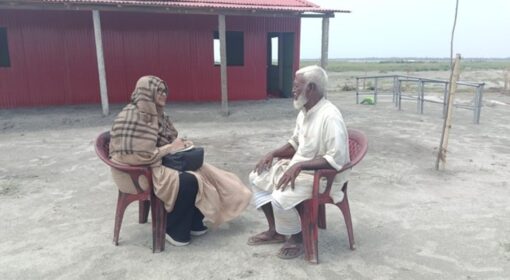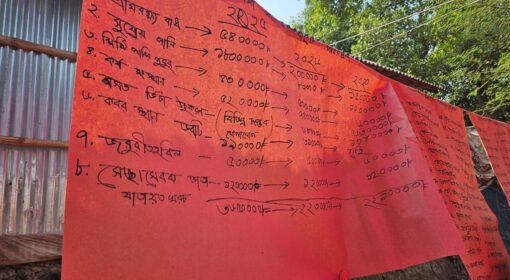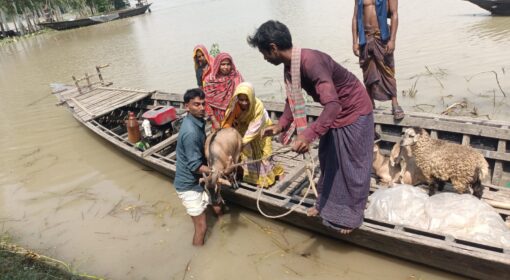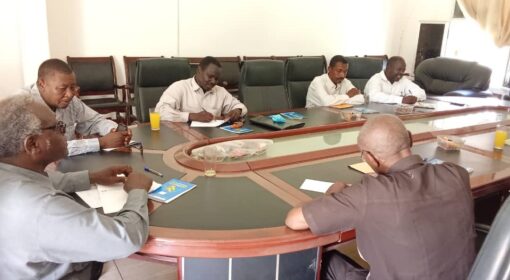By the Char Gujimari Community Implementation Committee, Mr. Ambor Ali (President, CIC) and Mst. Jannatul Naim
This blog is part of a dossier on locally-led adaptation, featuring insights and lessons from the Reversing the Flow (RtF) program. RtF empowers communities in Bangladesh, Burkina Faso, Ethiopia, Kenya, and Sudan to build climate resilience through direct funding and a community-driven, landscape approach.
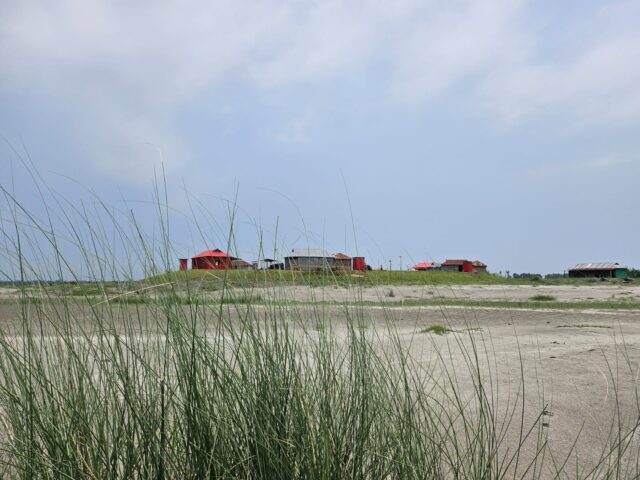
Char Gujimari, Saheber Alga Union, May 15, 2025 — A powerful story of resilience unfolded as thirty members of the Community Implementation Committee (CIC) from ten different char communities under the RtF programme supported by Friendship NGO, set foot on the raised plinth of Char Gujimari. Hosted by the people of Gujimari themselves, the day became a vibrant classroom of real-life learning where hardship met innovation, and traditional knowledge merged with climate action.
Char Gujimari, a remote sandbar island nestled in the Brahmaputra River within Kurigram District, is home to 245 families. Here, floods, river erosion, and natural disasters are not rare episodes, they are recurring realities. Despite having little formal understanding of climate change, the people of Gujimari live its consequences every day. They face the compounding challenge of protecting their families, livestock, and livelihoods with extremely limited resources during the flood time.
During the exchange visit, stories were shared not from textbooks, but from lived experiences among communities. In one such moment, Mr. Amber Ali, President of the Char Gujimari CIC, said:
“We are poor people who have lived on these chars for generations. In my 75 years, I have experienced river erosion 31 times. We cannot afford to buy land on the mainland. We farm, we fish, we rear livestock—but with every flood, our lives become more difficult. There was no place to take shelter during emergencies.”
That reality began to shift when Char Gujimari was included under the RtF programme. Through an inclusive and consultative process, the community formed their own CIC and received a regrant of approximately €27,000 in 2024. With full decision-making power in their hands, the community determined their top priority: building a raised plinth (a specially designed elevated homestead ground for the community) for collective emergency shelter, a decision born out of memory, urgency, and foresight.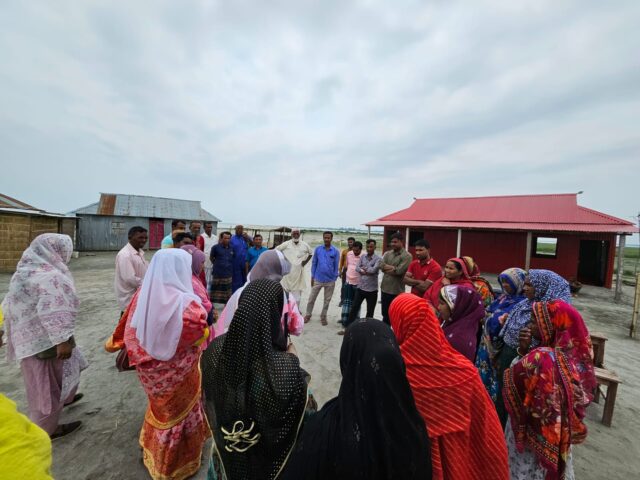
The plinth was not the only achievement. The CIC also implemented six tube wells for safe drinking water, solar-powered lamp posts, a community cattle shed, and even space for a school all guided by the needs they identified themselves. This was not just adaptation; it was ownership, dignity, and the essence of community-led resilience.
A particularly meaningful discussion unfolded during the exchange visit when visitors raised a concern: the plinth’s location is less than 1.5 kilometers from the river. Would it last?
Mr. Amber Ali shared how the selection of the plinth site was the community’s first major challenge and their first victory in applying LLA. He explained that convincing fellow villagers to donate land in the central part of the char wasn’t easy. Those lands were more secure, farther from the river, and used for homesteads or farming. Community members were hesitant to give up their most secure land for a project they were leading themselves, something they were used to seeing planned and built by other doners, Friendship NGO or government experts. But together again in community courtyard meeting with CIC, they reflected on past flood disasters. They analyzed the hydro morphology of the river using their own traditional knowledge, observed patterns of flow, erosion trends from their lifelong experience, and the availability of materials like sand from the river. Ultimately, they identified the unused area seems to be more secure, with low transport costs and feasible sand access. It was a strategic, informed, and community-agreed decision. This decision was crucial to access a safe place during the flood time.
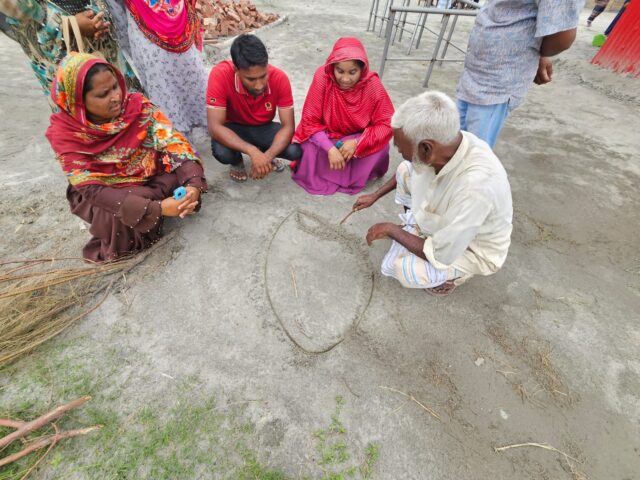
“We made this decision together, based on what we know and what we’ve seen over the years,” Mr. Ali explained while presenting a hand-drawn map showing river flow. “It may not be perfect, but it is ours. We know natural calamities are unpredictable, but we need to take risks for our survival, made by our own hands and minds, gives us hope. If we get stuck somewhere, we’ll find another way and start again. This is our work; we have to do it for ourselves.”
Visitors from other chars shared the pressing issues faced in their own communities and engaged in open dialogue to explore sustainable solutions together. For many, this was the first time witnessing a large-scale initiative planned, funded, and implemented entirely by a community itself, something never practiced before the RTF project. The experience sparked new hope, trust and confidence, showing that through the LLA approach.
In the closing line of event from Mr. Ambor Ali on behalf of Gujimari community, capturing his message clearly and powerfully:
“We live hand to mouth—maybe we can manage something small for our own families, but doing something big for the whole community, like restoring the land, needs a lot of money. That’s something we could never afford ourselves, as we’re always busy meeting urgent daily needs. But when we got this regranting support through the RTF project, it brought back our hope. It made us believe that we can survive better, right here on our own land.”
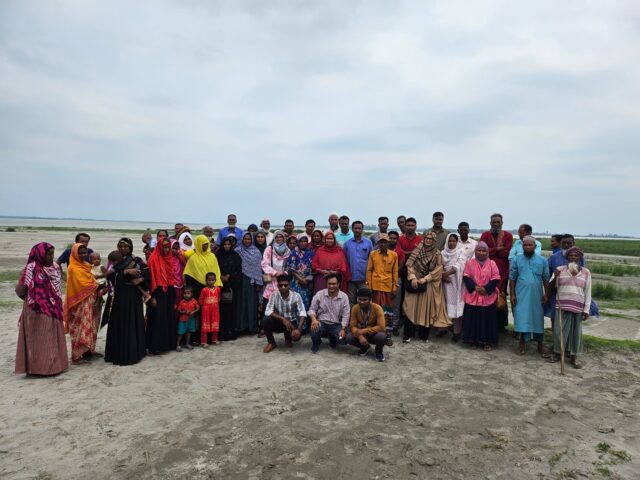
How the RTF Approach Breaks from Tradition:
The Char Gujimari experience shows a clear difference between traditional top-down approaches and the Locally Led Adaptation model. In traditional projects, decisions like where to build, how to design, and how to spend funds are often made by outsiders leaving communities with little voice or ownership. Local knowledge is often ignored, and risk-taking is discouraged. A locally led approach puts power in the hands of the community. In Gujimari, people used their own understanding of the river, land, and past floods to choose a nearby site for the plinth. While the location seemed risky, it offered quick access to materials (sand) and was supported through land donation. This gave the community a window of time to prepare for longer-term sustainability. The Locally Led approach allowed them to act on their priorities, take informed risks, and build resilience on their own terms, something the traditional model rarely allows.
In the end, the visit affirmed a powerful truth: resilience doesn’t come from outside it grows from within. And when communities are trusted, resourced, and respected, their journeys toward resilience are not only possible but sustainable.
